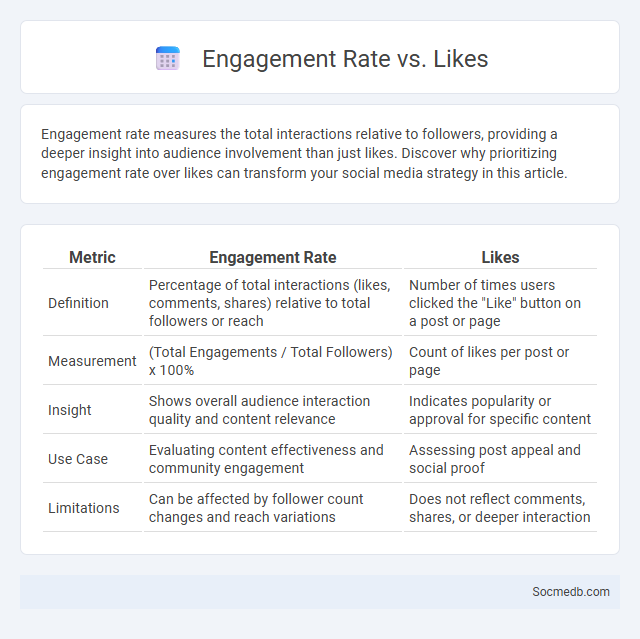
Photo illustration: Engagement Rate vs Likes
Engagement rate measures the total interactions relative to followers, providing a deeper insight into audience involvement than just likes. Discover why prioritizing engagement rate over likes can transform your social media strategy in this article.
Table of Comparison
| Metric | Engagement Rate | Likes |
|---|---|---|
| Definition | Percentage of total interactions (likes, comments, shares) relative to total followers or reach | Number of times users clicked the "Like" button on a post or page |
| Measurement | (Total Engagements / Total Followers) x 100% | Count of likes per post or page |
| Insight | Shows overall audience interaction quality and content relevance | Indicates popularity or approval for specific content |
| Use Case | Evaluating content effectiveness and community engagement | Assessing post appeal and social proof |
| Limitations | Can be affected by follower count changes and reach variations | Does not reflect comments, shares, or deeper interaction |
Introduction to Engagement Metrics
Engagement metrics on social media measure the level of interaction and involvement your audience has with your content, including likes, comments, shares, and clicks. These metrics provide valuable insights into how well your posts resonate and drive user participation. Understanding engagement helps you refine your strategy to increase visibility and build a loyal community around your brand.
Defining Engagement Rate
Engagement rate measures the level of interaction your content receives from your audience, including likes, comments, shares, and clicks. This metric provides valuable insights into how effectively your social media strategy resonates with followers and drives meaningful connections. Understanding engagement rate helps you optimize content to boost visibility and foster stronger community relationships.
Understanding Likes as a Metric
Likes on social media serve as quantifiable indicators of user engagement, reflecting content popularity and audience approval. Analyzing like metrics helps marketers gauge the effectiveness of posts, informing content strategy and targeting efforts. However, relying solely on likes overlooks deeper interactions such as comments and shares, which provide richer insights into audience behavior.
Engagement Rate vs Likes: What’s the Difference?
Engagement rate measures the total interactions, including likes, comments, shares, and clicks, relative to follower count or impressions, offering a comprehensive view of audience involvement. Likes represent a single form of engagement, indicating approval but lacking depth compared to comments or shares, which signal stronger audience connection and content resonance. Brands prioritize engagement rate for evaluating social media performance because it reflects authentic user interaction beyond superficial approval metrics.
Why Engagement Rate Matters More Than Likes
Engagement rate measures the quality of interactions on social media by tracking likes, comments, shares, and clicks relative to follower count, providing deeper insight into audience interest than raw like numbers. Higher engagement rates indicate a loyal and active community, which improves algorithmic ranking and content visibility on platforms like Instagram and Facebook. Brands prioritize engagement rates to gauge campaign effectiveness, optimize content strategies, and drive meaningful user actions beyond superficial approval.
Calculating Engagement Rate: Methods and Examples
Calculating engagement rate involves dividing the total interactions--likes, comments, shares--by the number of followers or impressions, then multiplying by 100 to get a percentage. Common methods include engagement rate by followers, engagement rate by impressions, and engagement per post, each tailored to different campaign goals. Understanding these metrics helps you accurately assess your social media performance and optimize content strategy for higher audience interaction.
Pros and Cons of Using Likes
Likes on social media platforms boost your content's visibility and engagement, enhancing brand awareness and providing valuable feedback. However, the emphasis on likes can create pressure, foster unhealthy comparisons, and distort content quality in favor of popularity metrics. Balancing the pursuit of likes with authentic interaction is crucial for sustainable social media success.
Industry Benchmarks: Engagement Rate and Likes
Social media industry benchmarks reveal that average engagement rates vary by platform, with Instagram typically achieving around 1.22%, Facebook 0.08%, and Twitter 0.045%. Likes serve as a key performance indicator, with Instagram posts averaging 3.5% engagement through likes and comments combined. Brands striving to outperform these metrics should focus on creating compelling content tailored to their target audience to boost interaction and visibility.
Improving Your Engagement Rate: Practical Strategies
Boosting your social media engagement rate involves creating compelling content tailored to your audience's interests and encouraging active interaction through questions, polls, and calls to action. Leveraging analytics tools helps you identify peak posting times and the types of posts that resonate most, optimizing your content strategy for maximum reach. By consistently engaging with your followers through comments and messages, you build a loyal community that significantly enhances your online presence.
Choosing the Right Metric for Social Media Success
Selecting the right metric for social media success depends on campaign goals such as brand awareness, engagement, or conversions. Important metrics include reach and impressions for visibility, likes and comments for engagement, and click-through rates or conversion rates for driving actions. Aligning metrics with specific business objectives ensures accurate measurement of social media performance and ROI.
 socmedb.com
socmedb.com